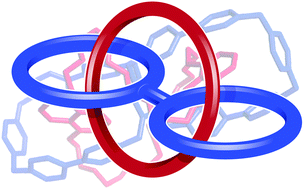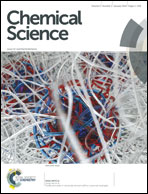Topological isomerism in a chiral handcuff catenane†
Abstract
The self-assembly of two topological isomers of a handcuff catenane has been achieved by utilizing the template-directed synthesis between the π-electron-rich bis-1,5-dioxynaphtho[50]crown-14 and the precursors to two fused π-electron-deficient cyclobis(paraquat-p-phenylene) cyclophanes. Characterization of the product using 1H NMR spectroscopy and single-crystal X-ray diffraction, with supporting density functional theory (DFT) calculations, suggests that the 1,5-dioxynaphthalene units in the major topological isomer align themselves with the same relative orientations inside the cyclophanes on account of restrictions imposed by the lengths of the polyether loops. The DFT calculations also reveal that the energies of the two topological isomers are similar to each other, supporting the experimental observation that both isomers can be isolated as a mixture from a one-pot reaction. The two isomers – designated as the meta–meta and ortho–ortho isomers with different topologies that are not interconvertible – only differ in the manner in which the polyether loops wind their way around the central 1,2,4,5-tetrasubstituted benzenoid ring in the ditopic host. X-Ray crystallography proves that by far the major topological isomer in the solid state is the meta–meta one. 1H NMR spectroscopy confirms that it is also the major isomer in solution, whilst also revealing the presence of a minor isomer, which is assumed, for the time-being, to have the ortho–ortho topology. The free fused ditopic host has been obtained using a protocol similar to that employed in the template-directed synthesis of the handcuff catenane, except that the crown ether is replaced with an acyclic template which can be removed post-synthesis. The results of isothermal titration calorimetry studies shed some light on the mechanism of binding of π-electron-rich guests: they lead us to believe that when two electron-rich guests bind to the ditopic host, they do so with allosteric negative cooperativity.


 Please wait while we load your content...
Please wait while we load your content...